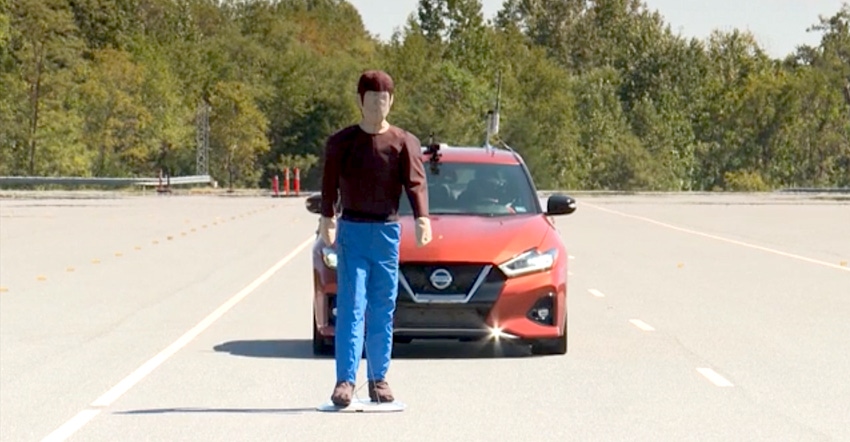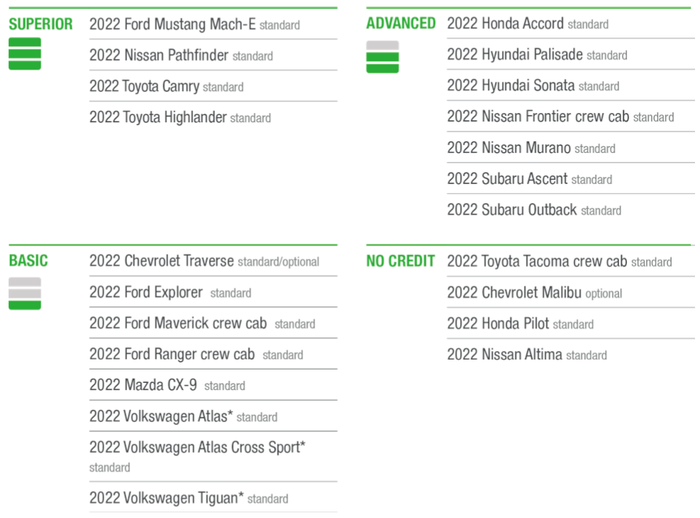IIHS Flunks Half the Class in Nighttime Collision Avoidance
The IIHS test finds fewer than half of the tested cars could spot pedestrians in the dark well enough to avoid hitting them.

Following up on its research showing that automatic emergency braking systems do not appear to be working to prevent collisions with pedestrians after dark, the Insurance Institute for Highway Safety (IIHS) has tested these systems in the dark and found that only half of them provide any benefit.
“As we expected, most of these pedestrian AEB systems don’t work very well in the dark,” says IIHS President David Harkey. “But it’s clear automakers can rise to this new challenge, as Ford, Nissan and Toyota each earn superior ratings for some models.”
The IIHS tested 23 midsize cars, SUVs, and small pickups to evaluate their ability to brake when pedestrians cross their path in the dark. Four vehicles stood apart from the rest; the Ford Mustang Mach-E, Nissan Pathfinder, Toyota Camry and Toyota Highlander, which were awarded IIHS’s “superior” score. In contrast, daylight testing of these same vehicles classified 19 of them as superior.
”It’s discouraging that so many midsize SUVs and small pickups perform poorly in the nighttime test because research suggests these types of vehicles are more dangerous to pedestrians,” says Harkey.
Seven more vehicles — the Honda Accord, Hyundai Palisade, Hyundai Sonata, Nissan Frontier, Nissan Murano, Subaru Ascent and Subaru Outback — earn advanced ratings in the nighttime testing. That leaves 12 others that finished in their the “basic” or “no credit” categories.
To test the systems, the IIHS set up a nighttime test with two common pedestrian crash scenarios, an adult crossing the road and an adult walking along the road at the edge of the travel lane. They recreated the ambient lighting of a full moon, less than 1 lux.
These are the same tests used for the daytime evaluation, but that also includes having a child step into the road from between two parked cars. Because few child pedestrian fatalities occur at night, that test was not used.
The cars in the crossing test travel at 12 mph and 25 mph, and at 25 and 37 mph in the parallel test. Scores are awarded based on the average speed reductions in five repeated test runs on dry pavement. Separate trials are conducted with the headlights on the high beam and low beam settings, and scores are adjusted if the vehicle is equipped with high beam assist to automatically switch on the high beams when no other vehicles are nearby.
The Pathfinder avoided the pedestrian dummies in all of the tests, while the Camry, Highlander, and Mach-E avoided the crashes in all by the 37-mph parallel test, when they slowed substantially to lessen the impact.
Sensor fusion, adding other sensors to the visible light cameras normally used currently, would help address the shortcomings of automatic emergency braking systems. Each claims its own advantages, but it seems obvious that sensors that don’t depend on visible light are needed for automatic emergency braking to be effective at night.

About the Author(s)
You May Also Like





